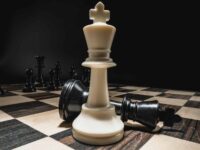You hear about it on TV, on the radio, in the newspapers but you don't know what the NFT ? NFTs (Non-Fungible Tokens) are unique tokens on the blockchain that can certify the authenticity and ownership of a digital work of art.
These "tokens" are becoming increasingly popular in digital art and are having a significant impact on how we view and value this art form. They allow artists to monetize their work in a more direct and transparent way, while providing proof of ownership for buyers.
The growing importance of NFT in digital art
NFTs in digital art have been growing steadily in recent years. Thanks to blockchain technology, NFTs allow artists to create unique works of art and traceable, providing proof of authenticity and ownership for buyers.
This has opened up new opportunities for artists to monetize their work in a more direct and transparent way, without having to go through art galleries or intermediaries.
The NFTs have also created a online community of digital art collectors and investors, which has contributed to the growth of this industry.
Over the past few years, sales of digital art in the form of NFT have exploded, with works sold for millions of dollars!
NFTs change our perception of digital art
NFTs enable unique, traceable artworks to be created on the blockchain
Using the technology of the blockchainNFTs can be used to certify the authenticity and ownership of a digital work of art.
In other words, this means that each NFT is unique and cannot be copied or duplicatedThis makes it an irrefutable proof of the originality of the work of art.

Another important point is that the blockchain allows the history of each NFT to be tracked, which provides a complete transparency on its ownership and value.
In addition to enabling the creation of unique and traceable works of art, NFTs offer a proof of ownership and authenticity for digital artworks: when a buyer purchases an NFT, he receives a unique token on the blockchain that allows him to prove that he is the the rightful owner of the associated work of art.
The security is therefore twofold:
- for buyers, who can be assured that the work they are purchasing is the original and not a copy.
- for the artists: who can have the guarantee that their work is protected, and will not be a source of counterfeit or copyright violations.
Another interesting angle is that NFTs allow artists to avoid intermediaries such as art galleries and agents, thus retaining more of the benefits of their work.
The NFTs offer complete transparency on the sales and pricesThis makes it easy for artists to follow their success in the market.
Proof of ownership and authenticity for digital artworks
NFTs provide proof of ownership and authenticity for digital artworks, using blockchain technology. By purchasing an NFT, a buyer receives a unique token on the blockchain that allows them to prove that they are the rightful owner of the associated artwork. This provides additional security for buyers, who can be assured that the work they are purchasing is the original and not a copy. In addition, it allows artists to protect their work from counterfeiting and copyright infringement. By using NFTs, artists can create unique and traceable artworks on the blockchain, providing proof of authenticity and ownership for buyers.
Examples of artworks sold as NFT
There are many examples of artworks sold as NFTs, with impressive sale prices and a significant impact on digital art.
In March 2021, a digital art piece titled "Everydays: The First 5000 Days" by crypto-populist artist Beeple was sold at auction for $69 million as an NFT. The sale was a record for an NFT and highlighted the rapid growth of the industry.
Another example is the digital artwork entitled "The Fungible Collection" by artist Trevor Jones, which sold for $5.2 million in January 2021, or "The First Supper" by artist Mad Dog Jones, which sold for $6.6 million in February 2021.
These sales confirm that NFTs have become a popular way for artists to monetize their work in digital art, with record sales price.
The figures above illustrate the growing importance of NFT in digital art and their ability to change the way we view and value this art form.

Criticism and controversy around the NFTs
But NFTs are not without their critics and are not necessarily as virtuous as we would like.
Ecological sustainability and equitable access to digital art
The blockchain technology used to create and store NFTs consumes a significant amount of energyThis can be problematic in the age of ecological sustainability.
Recall that mining and using crypto-currency requires the use of large data centers and computer equipment, which has an undeniable negative impact on the environment.
NFTs are also often expensive to purchase and store, which can limit access to digital art for some people. This can create a barrier for emerging artists and small-scale collectors, limiting equal access to digital art. Some feel that this may hindering diversity and inclusion in the digital art industry, by favoring the wealthiest artists and buyers.
In sum, critics of NFTs highlight issues of ecological sustainability and equitable access to digital art, which may harm the digital art industry in the long run. Advocates of NFTs argue that these problems can be solved through technological solutions and ethical business practices, but the debate on these issues remains open.
What is the real value of NFTs as works of art?
There is a debate about the real value of NFTs as artworks. Some believe that they are just a passing fad and do not represent a true value for digital artworks. They argue that NFTs are just tokens on the blockchainwhich does notdo not reflect the artistic quality of the work of art associated.
They also point out that NFTs can be copied or duplicated, which can dilute their long-term value.
Conversely, "pro NFTs" argue that these tokens offer a new way to value digital art and allow artists to monetize their work more fairly. They point out that NFTs offer proof of authenticity and ownership for buyers, thus increasing the value of digital artworks in the long run.
Video: NFT, the boom of virtual works
So in the end, what do we think of this new world of NFTs?
NFTs are becoming increasingly popular in digital art and are having a significant impact on the way we view and value this art form. However, as you can see, NFTs are controversial in their own right but also for their ecological consequences.
Whether it is a passing fad or a new and lasting way of "consuming" art, everyone will make up their own mind!
"



